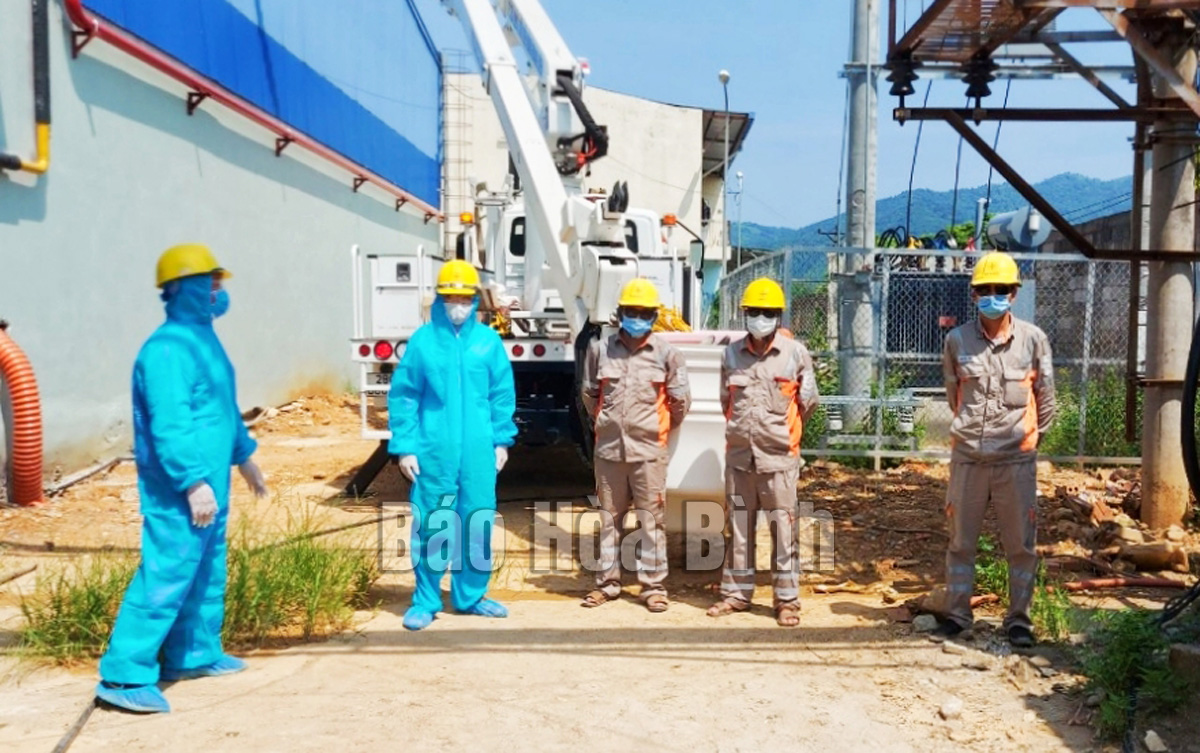
(HBO) - Following the direction of the Northern Electricity Corporation (EVNNPC), Hoa Binh Power Company has implemented the third and fourth phases of electricity price and service charge reduction for customers affected by the COVID-19 epidemic.
Photo: Officials and staff of Luong Son Power Company review the groups of customers eligible for electricity charge reduction scheme in the fourth phase.
Customers benefiting from the fourth phase of reduction are residents of districts/city which were under social distancing measures following the Prime Minister’s Directive No. 16/CT-TTg on July 30.
Customers consuming less than 200kWh per month enjoy a 15 percent reduction of their pre-tax electricity cost, while those using more than 200kWh per month will get a 10 percent reduction. The reduction will be applied for bills for August and September.
Nguyen Phuc Thinh, Director of the Hoa Binh Power Company said that in order to make sure customers know about the support, the firm has informed payment receiving partners (banks, payment organisations, rural power service teams) on the method of calculating the bills and changes in power prices.
The reduction will be clarified in the bills and receipts, he said, adding that transaction staff have received training in how to give explanation to customers and answer their questions.
Thinh said that as part of efforts to comprehensively implement the scheme and protect the interests of customers, the firm has assigned its IT Department to update the charge collection software to clarify information on the reduction of electricity prices and bills, so that customers get the full information.
Meanwhile, guiding documents from the Ministry of Industry and Trade, the Vietnam Electricity and the EVNNPC regarding the scheme will be updated.
Earlier, the Hoa Binh Power Company launched the third phase of power bill reduction for bills in June and July, benefiting 204 customers with total reduction of 2.6 billion VND (114,057 USD).
In the fourth phase, about 27,000 customers in Luong Son district are expected to benefit from the programme with total reduction of nearly 3 billion VND./.
The Department of Education and Training of Hoa Binh province held a conference on March 18 to review the performance of the "Safe and Happy School" Project and set out tasks for 2025. The project, funded by the Taiwan Fund for Children and Families (TFCF), aims to create a safe, inclusive, and supportive learning environment for students. The event saw the attendance of representatives from the TFCF and 26 beneficiary schools.
With over 70% of their workers being women, trade unions across industrial parks (IPs) in Hoa Binh have been actively safeguarding their legal rights and interests while implementing initiatives to improve their income and well-being.
In recent years, the Hoa Binh provincial General Hospital has continuously innovated itself and improved the quality of medical services to meet the increasing needs of local people. With substantial investments in infrastructure and modern equipment, along with a team of highly qualified doctors and nurses, the hospital has gradually established itself as one of the leading medical units in the Northwestern region and a trusted destination for healthcare for people inside and outside the province.
From mastering the fundamentals of programming to achieving national recognition, the Programming Club of the Le Van Tam Primary School (STAR LVT28) in Hoa Binh city has made remarkable strides in the field of robotics.
The Ho Chi Minh Communist Youth Union Committee and the Vietnam Youth Federation chapter of Hoa Binh province organised a programme on March 12 to launch the "Digital Literacy" movement and an online quiz on the resolutions of the Vietnam Youth Federation congresses at all levels, as well as the Politburo's Resolution No. 57-NQ/TW on breakthroughs in the development of science, technology, innovation, and national digital transformation.
As climate change grows more unpredictable, the development of production forests has become essential - not just for economic growth, but for safeguarding the environment and maintaining ecosystem balance. By boosting local incomes, curbing natural disasters, preventing soil erosion, and protecting water resources, these forests play a crucial role in sustainable development.



